Anthuriums are members of the Aroid (Araceae) family, and the genus is known for its bright spathes and yellow or red flower spikes that resemble a tail.
They are epiphytic plants that grow on other plants or organic humus and flourish in warm and tropical climates.
Anthurium is native to the Caribbean as well as in Northern and Central America.
Their blooms and leaves are exotic, but for a variety of reasons, the leaves may turn yellow.
Table of Contents
What Causes Anthurium Leaves to Turn Yellow?
Anthurium leaves turn yellow due to changes in their care habits. This includes over-watering the foliage, low humidity, exposure to excessive sunlight, and feeding it with poor fertilizers. However, fluctuation in temperatures and providing a weak soil mixture can also result in yellow leaves.
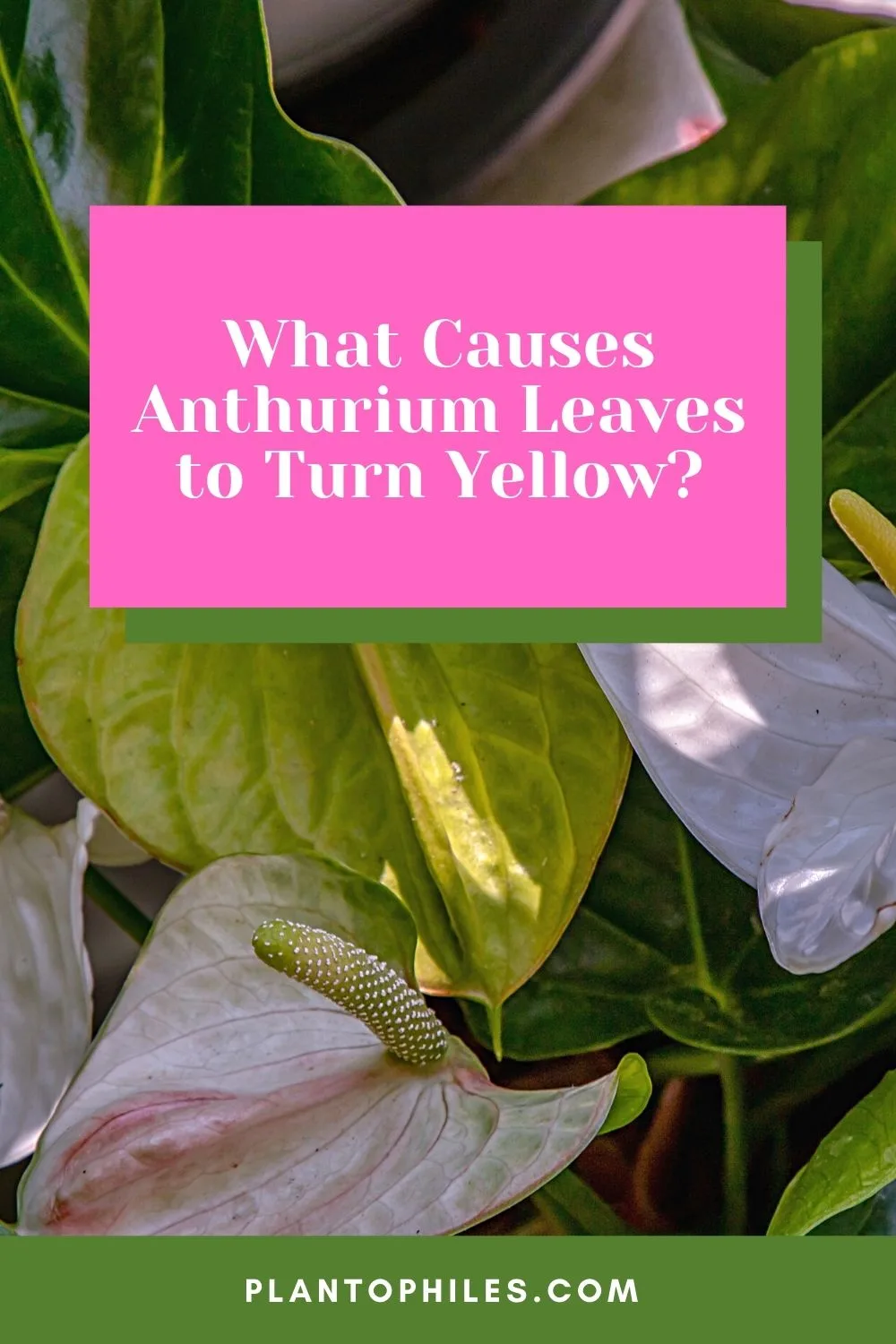
What Causes Anthurium Leaves to Turn Yellow?
What Anthurium Leaves Look Like
The leaves of young Anthuriums resemble tiny hearts. Some varieties have oblong or upright lanceolate leaves.
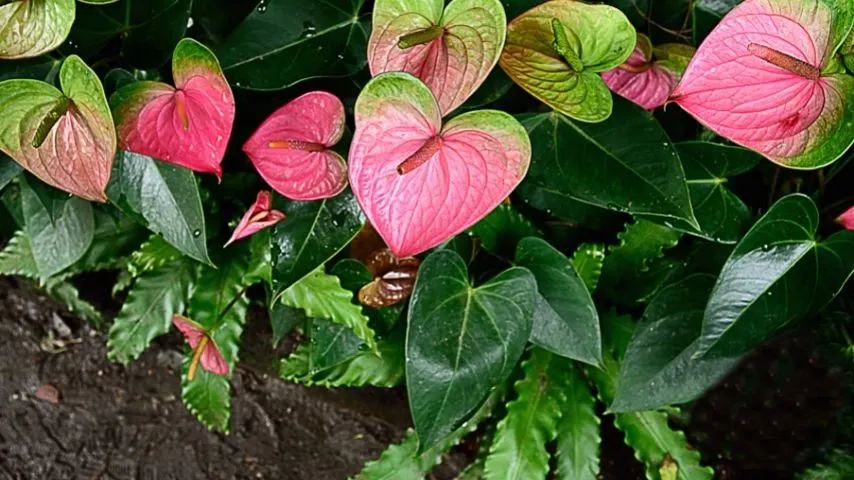
The leaves of the Anthurium plant resemble tiny hearts
The foliage is sometimes seen attached to thin and skinny long stems. Anthuriums also have long spadix bearing tiny flowers that are attached to plain and green spathe.
The real beauty of Anthurium lies in the different textures and shapes of the foliage.
6 Troubling Causes of Yellow Leaves on Anthurium Plants
Yellow leaves on Anthuriums should be treated as soon as possible because they can lead to a decline in plant health.
After caring for Anthurium plants for several years, I have compiled a list of six significant issues that usually lead to yellow leaves on most Anthurium varieties.
1. Over-Watering
Anthurium plants require their soil to be moist, not soggy. It becomes your job to make sure to keep the maintain correct moisture level when you water your Anthurium.
If the soil stays wet for too long, it will lead to root rot, which is a dangerous situation for any plant.
The soil would prevent aeration, and the roots would essentially suffocate.
Overwatering would cause the leaves to become wrinkled and turn yellow in no time. The flowers would lose their colors, and the foliage would wilt.
The soil of an Anthurium plant doesn’t ever dry up and remains moist for an extended period. It becomes essential to provide gaps in-between watering.
A well-draining potting mix is a great way to make sure your Anthurium plant is never over-watered.
With just a potting mix, you can also make sure that excessive humidity is also expelled.
2. Improper Humidity Level
If you have stabilized the watering schedule, but the foliage is still turning yellow then the main issue would be the humidity level exposure.
Anthurium plants come from tropical forests where the humidity level is high as compared to your house. The indoor humidity level is not constant enough and is arid at times.
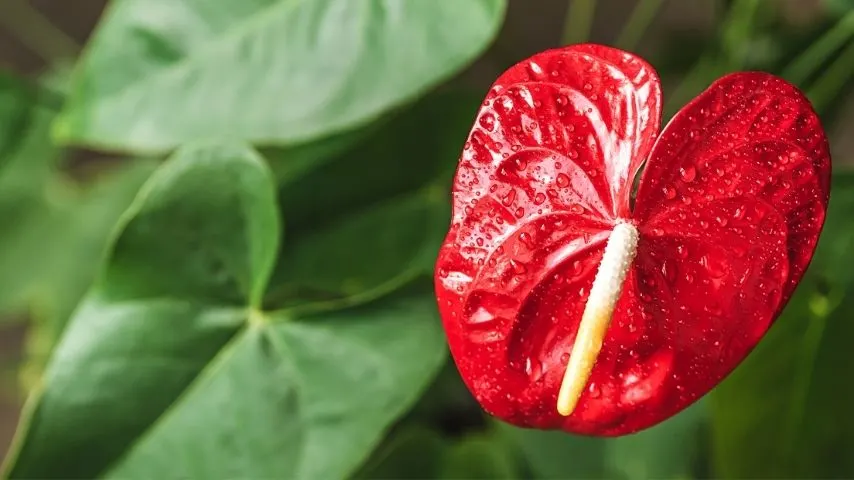
Since Anthurium plants come from tropical forests, they thrive best in a high-humidity area
Since Anthurium plants come from tropical forests, they thrive best in a high-humidity area
The situation for indoor Anthuriums becomes worse in winters as the plant is exposed to heating systems. This causes the drying of the air and humidity simultaneously.
More humidity causes the leaves to become excessively moist to the point that they are too wet to touch.
This constant change in humidity levels can lead to the leaves turning yellow and wrinkling away.
You can maintain optimum humidity for your indoor Anthuriums in several ways.
- Place your Anthurium on a water tray filled with pebbles.
- Place the anthurium plant with other plants creating a mini-greenhouse where the humidity level is managed by all of them together.
- Misting is also a good option. Mist the leaves once a day.
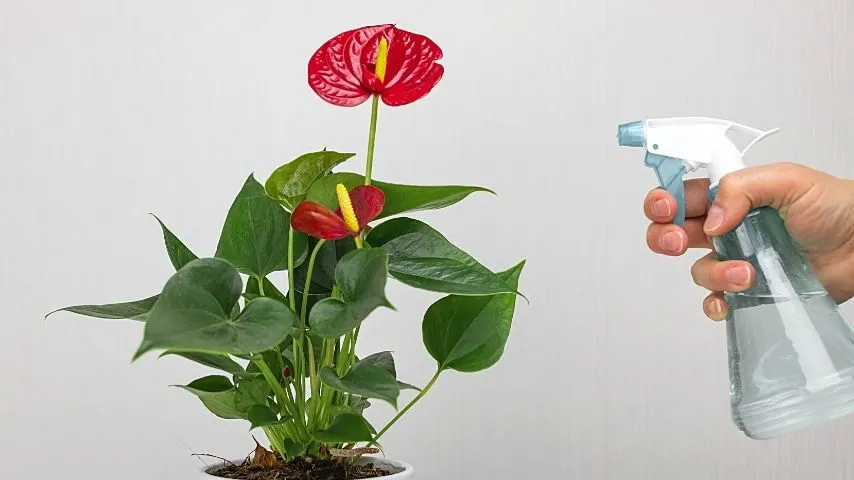
Misting your Anthurium’s leaves at least once a day can help maintain optimum humidity indoors
- Humidifier also keeps the humidity level in check.
3. Ineffective Fertilizers
Anthuriums don’t require a lot of fertilization, but they still appreciate a regular dose of houseplant fertilizer.
The correct way to fertilize Anthurium is to feed it with a fertilizer that’s water-soluble once in a month.
However, over-fertilizing the Anthurium plant can lead to damage to its leaves. Excessive nutrients would become toxic to the plant would cause the leaves to turn yellow from the toxicity present in the soil.
The nutrients will build up and prevent the plant from photosynthesizing.
You need to apply the fertilizer at ¼ of its recommended strength. For accurate application, follow the instructions provided with the product.
If you have gone overboard with fertilizing your Anthuriums, you should immediately take out the potted Anthurium. Wash the pot and leave the Anthurium be for a few days before repotting it.
4. Soil Quality
Soil plays a prominent role in allowing water and moisture retention which is essential for any plant’s healthy growth.
If the potting mix is not up to the mark, your plant won’t survive.
If the soil of your Anthurium plant doesn’t allow extra drainage or absorption of nutrients, the leaves are bound to turn yellow.
Most Anthurium varieties prefer a soil mixture that drains well but retains enough moisture for the plant to grow.
Aeration is also essential for the roots to have access to fresh air and prevent carbon dioxide from trapping in the soil.
If you believe your soil is not perfect, try making a new potting mix. Take an equal mix of peat moss and vermiculite or perlite for an ideal potting mix for Anthuriums.
This soil mix would allow leaves to flourish and maintain an adequate soil pH to prevent the leaves from yellowing.
5. Excessive or Low Sunlight
Direct sunlight is damaging to the Anthurium leaves. In their native areas, Anthuriums grow under the shade of trees.
The University of Florida recommends a light level of no more than 1500-2000 FC.
Exposure to direct sunlight might be the cause of the leaves turning yellow during hot, sunny months of the year.
Excessive sunlight would scorch the leaves, turn them yellow and sometimes inflict scorch marks and brown spots as well.
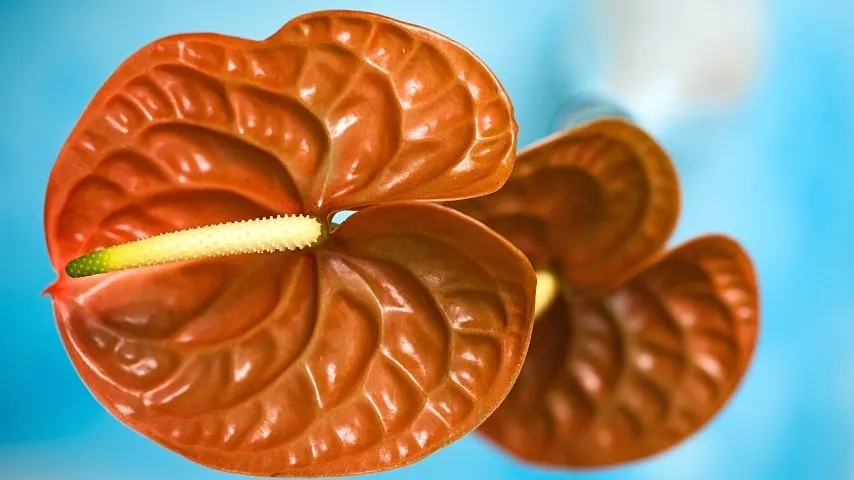
Exposing your Anthurium to excessive sunlight can scorch the leaves and turn them yellow
The Anthurium plants prefers indirect sunlight, which can be found in north, west, or east-facing windows.
If you have to place them near south-facing windows, put them a few feet away from the window.
However, low sunlight will also have drastic effects on the leaves. The Anthurium wouldn’t bloom in low light conditions and would grow slowly.
You can use fluorescent lights to maintain the light quantity.
6. Temperature Stress
If the temperature is above or below the recommended range, the Anthurium plants will react by developing discolored leaves.
Anthurium thrives in 70-85 Degrees Fahrenheit (21-29 Degrees Celsius).
However, cooler temperatures reduce the plant enzyme activity. It causes stress and slows down photosynthesis.
High temperatures would lead to leaves burning and turning yellow.
You must keep the temperature constant. Also, keep your Anthurium away from cold drafts and air conditioners.
Read more about Anthurium care.
Frequently Asked Questions about What Causes Anthurium Leaves to Turn Yellow
Should I try to prune the yellow leaves of my Anthurium?
If you don’t see any changes in the Anthurium leaves, it’s better to prune the leaves. Use the sterilized scissors and chop them away from the stems that are attached to the leaves.
What deficiency causes the yellowing of Anthurium leaves?
The loss of nutrients in the fertilizers sometimes causes Anthurium leaves to turn yellow. Nitrogen and Potassium deficiency would lead to discolored, yellow leaves as well as these nutrients are essential for the growth of lush green leaves.
How do you prevent the yellowing of Anthurium leaves?
It is recommended to provide gaps in between watering and always do a soil check. Keep the Anthurium leaves away from cold drafts and heating systems. Ensure you feed them with a fertilizer that’s balanced.

Daniel has been a plant enthusiast for over 20 years. He owns hundreds of houseplants and prepares for the chili growing seasons yearly with great anticipation. His favorite plants are plant species in the Araceae family, such as Monstera, Philodendron, and Anthurium. He also loves gardening and is growing hot peppers, tomatoes, and many more vegetables.


